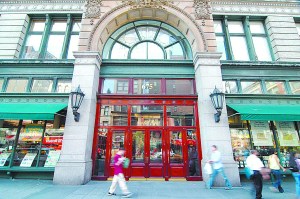 The building at 675 Sixth Avenue once housed Adams’ Dry Goods, one of New York’s first department stores to have automatic elevators. Now, 109 years later, still a trailblazer, the building will become one of the first in Manhattan to have a Trader Joe’s.
The building at 675 Sixth Avenue once housed Adams’ Dry Goods, one of New York’s first department stores to have automatic elevators. Now, 109 years later, still a trailblazer, the building will become one of the first in Manhattan to have a Trader Joe’s.
The landmarked address, called the Mattel Building since the 1980s, was largely for many years a three-tenant show: its eponymous occupant; some Gap Inc. offices; and, for nearly 15 years, a block-size Barnes & Noble.
Then, as Netflix did to Blockbuster, so has Amazon done to the giant book retailer, which vacated in April 2008 amid accusations of exorbitant rent. Leasing agent Robert K. Futterman and Associates has now filled the gaping Barnes & Noble hole with the unique grocer known for affordable wine.
More than its major tenants, though, the story of 675 Sixth is really the story of the surrounding neighborhood known as Ladies’ Mile, an historic stretch of retail that traditionally spanned 14th to 23rd streets, between Fifth and Seventh avenues. Some say its heyday began just after the Civil War; others that it was at the turn of the 20th century; and most agree that it ended by World War I, when major retail shifts, such as the relocation of Macy’s to its current Herald Square site, signaled the end of the era.
That period was one of social and economic flux, much of which was evident in the changes along Sixth Avenue. So the story of Ladies’ Mile is kind of the story of New York City.
AS WOMEN WERE emancipated from the home, and a middle class further emerged, a cluster of dry goods stores (what would later be called department stores) sprang up. Shopping was a new pastime, and nearly always left to women, hence the name Ladies’ Mile. The experience was not exactly sweet and feminine, with horse manure lining the street and the omnipresent clanging of the Sixth Avenue el. Among these stores were Macy’s; B. Altman; Hugh O’Neill Dry Goods; Simpson, Crawford & Simpson; and Adams’ Dry Goods, the original tenant of the six-story cast-iron-frame low-rise that still sits between 21st and 22nd streets.
Built in 1900, expressly for the dry goods store, the building was sold to the competitor next door, Hugh O’Neill, in 1906 because the original owner lacked an heir. The two stores were connected by a tunnel that ran under 21st Street. That venture failed, and the Adams’ Dry Goods building began its descent into a 90-year stretch of nameless light manufacturing, warehouses and vacancies.
“After Macy’s moved uptown, the rest of [the department stores of Ladies’ Mile] followed or failed,” says Gary Alterman of Robert K. Futterman, a current leasing agent for 675 Sixth. “It had been a dark, dry warehouse neighborhood. Then, about 15 years ago, they started converting to office.”
A New York Times article reported that “[by] the 1920s, all the giant stores had been converted to lofts and manufacturing. A 1940s photograph shows the old O’Neill store occupied by the Central Time Clock company, a machinery exchange and similar businesses.”
The pullout of department store B. Altman from the area inaugurated the beginning of the end for Ladies’ Mile. That store moved to Fifth Avenue and 34th Street in 1904. A Real Estate Record and Guide article of the same year predicted that move would spur others and “give the Avenue a very different atmosphere. Its architecture will be showy and so far un-businesslike; but it will be adapted to fashionable stores, patronized by wealthy clients. It will be ‘smart’ and ‘swell.’”
How right they were.
THE BUILDING, WHICH still bears Adams Dry Goods’ signage and has been restored admirably, began its revitalization in 1986 under the ownership of Israel Taub’s Chelsea Green. The firm began that year to restore 675 Sixth and 625 Sixth (between 18th and 19th) to install office space, and generated a fair amount of skepticism. Because Chelsea Green anticipated the buildings’ status as historic landmarks, which they received in 1989, the firm renovated the buildings in concert with the Landmarks Preservation Commission.


